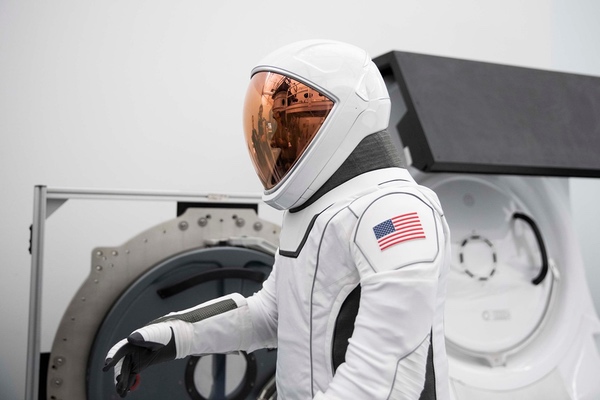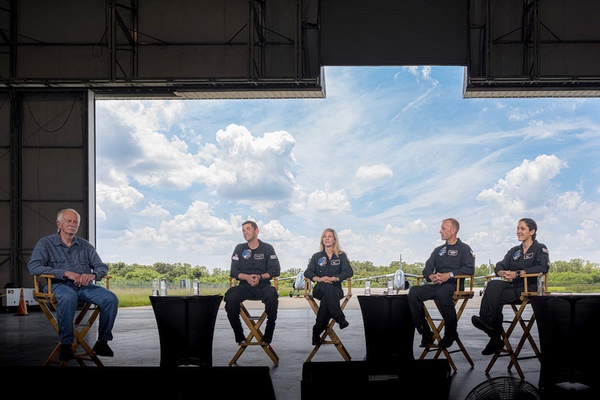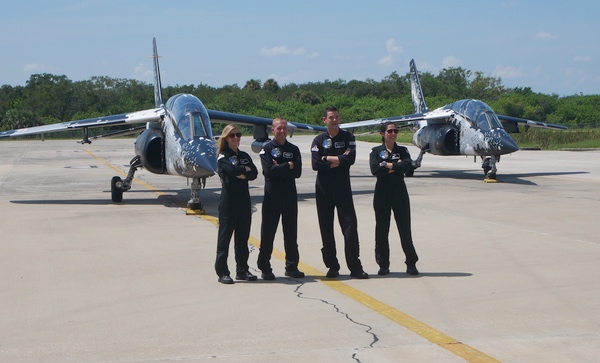Polaris’s dawnby Jeff Foust
|
| “The Polaris crew is helping to develop necessary technology needed to go to Mars,” said SpaceX’s Gerstenmaier. |
The “they” in that update was the crew of the Polaris Dawn private astronaut mission, and they reason why they could traverse 30 kilometers in a few minutes is because they were arriving on high-performance jets. Sure enough, a formation of jets soon flew over the former Shuttle Landing Facility runway (now called the Launch and Landing Facility by Space Florida) at KSC. Polaris Dawn had indeed arrived.
The jets delivered the four-person Polaris Dawn crew August 19 for final preparations ahead of the launch of the long-awaited, and long-delayed, mission on a SpaceX Crew Dragon. It is not the first private astronaut mission—its commander, billionaire Jared Isaacman, flew on another mission, Inspiration4, three years ago—but it is, arguably, the most ambitious, moving beyond a simple flight in low Earth orbit or visit to the International Space Station to one that will push the limits of the spacecraft and its crew.
“The Polaris crew is helping to develop necessary technology needed to go to Mars,” said Bill Gerstenmaier, SpaceX’s vice president of build and flight reliability and a former NASA associate administrator responsible for human spaceflight, during a briefing at the hangar by the Launch and Landing Facility shortly after the Polaris Dawn crew arrived. “The private sector is truly a portion of this great human spaceflight team.”
Unlike Inspiration4, which demonstrated the ability to safely fly a group of private astronauts with no spaceflight experience to orbit and back, or private missions to the ISS that follow in the footsteps of government missions there, Polaris Dawn will break new ground, at least for commercial missions. That will begin at launch, with the Falcon 9 placing the Crew Dragon spacecraft into an orbit with a perigee of 190 kilometers but an apogee of 1,200 kilometers. Hours after launch, the spacecraft will fire its thrusters to raise that apogee to 1,400 kilometers, making the crew the humans to travel furthest from the Earth’s surface since the Apollo 17 mission to the Moon in December 1972.
“Why do this?” Isaacman said at the briefing. “When you go into this environment, you’re dealing with totally different realities than, for example, when you would go to the to the space station.” That includes differences in the micrometeoroid and orbital debris environment as well as enhanced radiation exposure.
“We stand to learn quite a bit from that in terms of human health, science and research. If we get to Mars someday, we’d love to be able to come back and be healthy enough to tell people about it,” he said, not elaborating on how a brief exposure to a somewhat higher radiation environment could be extrapolated to a multi-year mission to Mars and back.
Polaris Dawn won’t spend long at that high apogee, lowering it to 700 kilometers after about ten hours. The crew will then turn its attention to arguably what it the highlight of the mission, the first spacewalk on a commercial mission or from a Crew Dragon spacecraft.
Preparations for the spacewalk will actually begin just an hour after reaching orbit, said Sarah Gillis, a SpaceX engineer who is one of two mission specialists on Polaris Dawn, with a “pre-breathe” protocol that will gradually lower the atmospheric pressure and increase the oxygen concentration inside the cabin.
On flight day two, the four astronauts will don their SpaceX-developed extravehicular activity (EVA) spacesuits for pressurization and mobility tests. SpaceX unveiled the suits, upgraded versions of the pressure suits previously worn on Crew Dragon flights, in May. “It’s an incredible suit,” she said, with changes that include cameras and heads-up displays in the helmet and new thermal insulation. An umbilical provides life support.
The spacewalk takes place on flight day three. Because there is no airlock in Crew Dragon, the entire cabin will be depressurized. That required changes to the spacecraft, Gillis said, such as more oxygen tanks to supply the suits and a nitrogen repressurization system once the spacewalk is complete. The spacecraft itself has gone through tests in a thermal vacuum chamber, including a long-duration test “so that we could bake out a lot of the materials on the inside, remove some chemicals that would offgas in the vacuum of the space before we’re actually in that environment.”
| “We’ll be fully outside Dragon,” Isaacman said of the spacewalk. “We’re just not going to be floating around.” |
All four astronauts will wear the EVA suits since the cabin will be depressurized, but only two—Isaacman and Gillis—will actually exit the spacecraft. They will use what SpaceX calls a “skywalker,” a set of rails and handholds mounted in the vicinity of the hatch in the nose of the capsule, taking the place of the docking port used for space station missions.
Earlier illustrations of the Polaris Dawn mission showed an astronaut floating free of the spacecraft, linked by a tether. Instead, each astronaut will briefly emerge from the hatch in a “stand up” EVA, keeping their hands and/or feet firmly attached to the spacecraft.
“We’ll be fully outside Dragon,” Isaacman said, including a “hands-free” test where only their feet are attached to Dragon. “We’re just not going to be floating around.”
“I think the picture was very cool,” he said of earlier illustrations, “but I think, as you know, Buzz Aldrin taught us that that’s not the right thing to do in an EVA.”
Isaacman and Gillis will individually go through the hatch for 15 to 20 minutes each. (“It’ll look like we’re doing a little bit of a dance,” he said, as they work through a “test matrix” to demonstrate the performance of the suit.) The entire EVA, from depressurization to repressurization of the cabin, will last about two hours.
Flight day four will involve a test of intersatellite data relays with SpaceX’s Starlink constellation. Neither the company nor the Polaris Dawn team have provided many details about what those tests will involve. “You’ll want to stay tuned for this,” was all that Anna Menon, another SpaceX employee who is the other mission specialist on Polaris Dawn, said.
That day, as well as the fifth day, will also be used for research. Menon said the mission has partnered with about 30 institutions from around the world to perform about 40 experiments in human health and related topics. One she highlighted is a contact lens equipped with sensors that astronauts will wear to measure changes in intraocular pressure in the eye that can cause vision to change while in microgravity.
The Crew Dragon will also be lowering its apogee during this time to set up for a reentry on flight day six, with a splashdown planned off the Florida coast.
 A key goal for the Polaris Dawn misison is to test EVA suits developed by SpaceX. (credit: SpaceX) |
Risks and rewards
Polaris Dawn is shaping up to be the most ambitious private astronaut mission to date, but one that is also perhaps the riskiest, due in large part to the spacewalk.
“EVA is a risky adventure, but we’ve done all the preparations,” Gerstenmaier said, citing the long work to develop and test the suit and train the crew. Taking those risks, he said, allows them to test advanced suit technologies. “I think it’s really a tribute to this team that they advance the state of the art, and we’re going to do it as safely as we can.”
“The EVA makes up the majority of the risks for Polaris Dawn,” Isaacman said. “Why would it be the riskiest part? Because you’re throwing away all the safety of your vehicle, right? It now comes down to, your suit becomes your spaceship.”
The extensive development time and training gave him confidence, he said, along with the rigor SpaceX applied to the work, such as “paranoia reviews” in the months leading up the flight. “I’d say, personally, I was almost concerned to some extent that we were way too focused on the EVA. What about all the other things?”
Those reviews caught issues relatively recently. Gerstenmaier said that SpaceX engineers found a “flammability concern” linked to static electricity discharges while in the pure oxygen environment of the suits.
| “I’d say, personally, I was almost concerned to some extent that we were way too focused on the EVA. What about all the other things?” Isaacman said. |
“The teams went in to mitigate that. They’ve changed procedures, they’ve changed processes, they’ve added conductive material, and we are truly ready to go fly,” he said. “This is an example of one of the many things that we learned on this flight that really haven’t been exposed before EVA suit development.”
Kidd Poteet, a former Air Force pilot who will be the pilot on Polaris Dawn, also discussed the extensive training for the mission. “I flew fighters for 20 years. I accomplished about 1,500 hours in the simulator training for combat, and that’s over 20 years,” he said. For Polaris Dawn, “this is two and a half years in the making, and over 2,000 hours.”
Besides the simulators, there was extensive training in everything from altitude chambers and centrifuges to scuba diving and climbing Cotopaxi, a mountain nearly 6,000 meters high in Ecuador. “So why is that important?” he said of the mountain climb. “Well, when it’s a multi-day journey to get to the summit, you’re dehydrated, you’re hungry, you’re grouchy because sleep sucks, and you learn a lot about yourself under this stressful environment, and you learn a lot about each other.”
Isaacman said all that work, and risk, was worth it. “It feels like a huge honor to have that opportunity to test it out on this flight,” he said of the EVA suit, seeing it as a precursor for a future suit that might be mass-produced for private missions to the Moon and Mars. “It’s not lost on us that—it might be ten iterations from now and a bunch of evolution to the suit—but that someday someone could be wearing a version of it that might be walking on Mars.”
 SpaceX’s Bill Gerstenmaier (left) and the Polaris Dawn crew at a briefing August 19. (credit: Polaris Program/John Kraus) |
A long wait
Development of the suit played a role in the schedule of the mission. When Isaacman and SpaceX announced the Polaris series of missions in February 2022, they anticipated flying Polaris Dawn late that year. But the mission’s schedule kept slipping.
Isaacman acknowledged at the briefing that the original schedule was too ambitious. “If it was the initial nine-month timeframe, I think you’d probably all be wondering how we were able to work that quickly,” he said. “I would say that this is one of the many kinds of philosophies that I’ve observed at SpaceX that gets people very motivated: you set some very, very ambitious deadlines up front to get people working really hard in the right direction.”
Those ambitious schedules, he said, are tempered by “sanity checks” in that process. “I think it was right in the beginning to say we’re going to try and achieve this at light speed.”
Suit development was not the only issue for the schedule. He cited development of the Starlink intersatellite links as well as modifications to the Dragon to enable it to depressurize and repressurize the cabin.
However, it was clear that a lot of effort went into suit development. “When we first started, we would come in every day for training and, pretty much every single day, we walk in and there would be a different suit,” Gillis recalled, as engineers tweaked various components of it. “There was this constant iteration of suit components with the suit team to test and collect data.”
| “Our company’s vision is to make us multiplanetary in the future. So this is an investment in the future,” said Gerstenmaier. |
But the completion of the suit hasn’t meant the end of delays. When the Polaris Crew arrived at KSC August 19, they were preparing for a launch in the early morning hours of August 26. That slipped a day for allow more time for vehicle preparations, then another because of a helium leak in the ground side of a quick-disconnect umbilical line.
Then the weather intervened. While conditions for launch itself were not an issue, SpaceX said they were postponing the launch because of concerns about splashdown weather at the end of the five-day mission.
“Our launch criteria are heavily constrained by forecasted splashdown weather conditions. With no ISS rendezvous and limited life support consumables, we must be absolutely sure of reentry weather before launching,” Isaacman posted on social media August 27. At the same time, the Falcon 9 was briefly grounded when a booster tipped over and exploded upon landing on a droneship early August 28; that booster, ironically, had launched Inspiration4 on one of its earlier flights.
SpaceX has not announced a new launch date, with this Friday now the earliest it could fly. (The launch time remains the same each day, with opportunities between about 3:30 and 7 am EDT.) Isaacman posted over the Labor Day weekend that the crew remains in quarantine in Florida, doing training like proficiency flights to stay ready when the weather cooperates.
Polaris Dawn is intended to be the first of three flights in a broader program, with the third intended to be the first crewed launch of SpaceX’s Starship. What the second flight will be remains uncertain, particularly after NASA ruled out in June doing any kind of private servicing mission to the Hubble Space Telescope, something that Isaacman had been advocating (see “Hubble limps along”, The Space Review, June 10, 2024).
At the briefing, Isaacman said only that the second flight would build upon the first in some way. He also declined to discuss the cost of Polaris Dawn: “Not a chance,” he said when asked for a rough estimate of how much he spent on the mission. (Isaacman, the founder and CEO of publicly traded payment processing company Shift4, is worth an estimated $1.9 billion, according to Forbes.)
Whatever he is spending—likely in the low hundreds of millions of dollars, based on best estimates of pricing for Crew Dragon seats—is a good deal for SpaceX, who is getting someone to help cover at least part of R&D work on systems like spacesuits. “I think it’s shared across the Polaris team, along with SpaceX,” Gerstenmaier said when asked what part of spacesuit development work was funded by the Polaris program. “But again, our company’s vision is to make us multiplanetary in the future. So this is an investment in the future.”
Note: we are now moderating comments. There will be a delay in posting comments and no guarantee that all submitted comments will be posted.
